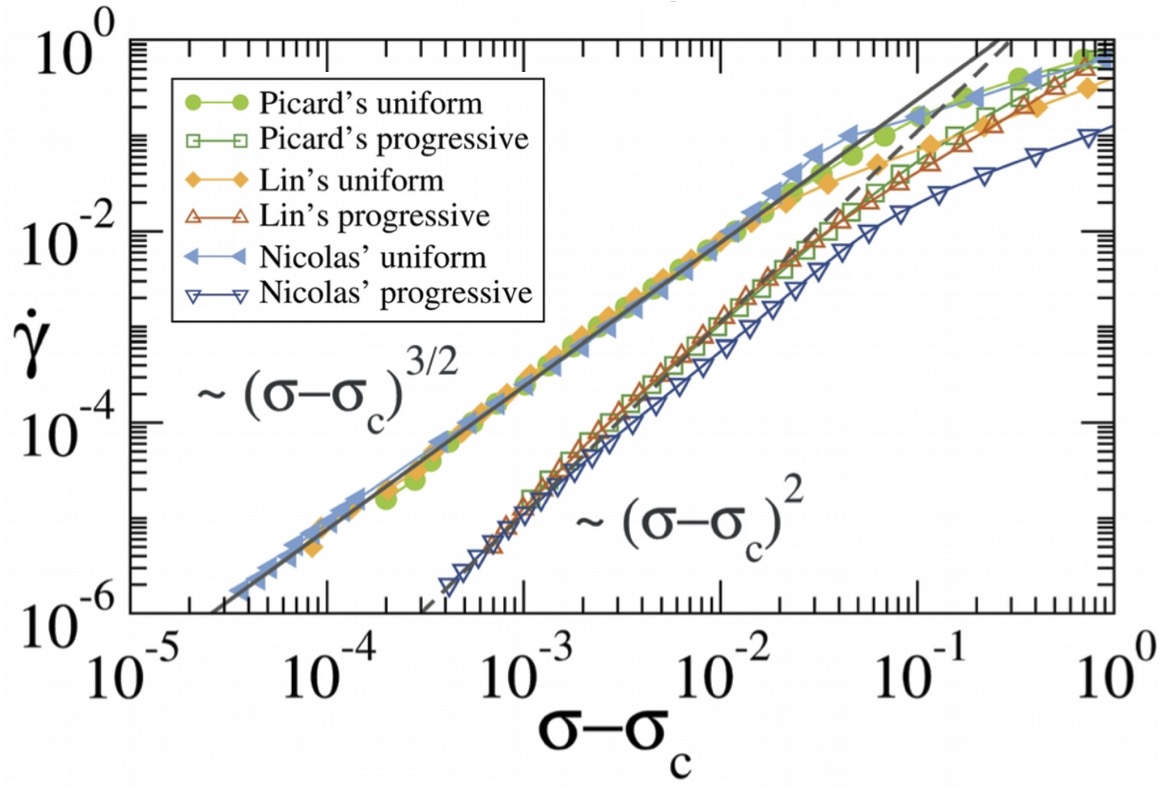
Title: Avalanche statistics and criticality at the yielding transition of amorphous solids
Speaker: Ezequiel Ferrero, Condensed Matter Theory group, Bariloche Atomic Centre, Argentina
Abstract:
In the last years, several groups have described the yielding phenomenon in the deformation of amorphous materials from a statistical physics point of view. To that end, coarse-grained approaches to amorphous solids were introduced, the so-called elasto-plastic models (EPM) [1]. In this talk, presenting a brief overview on the subject, I will focus on the statistics of avalanches produced by the characteristic stick-slip behavior close to the yielding transition, enquiring into its common properties among different EPM proposals.
More in depth:
I will present in particular the less studied case of EPMs with stress-dependent transition rates for local yielding [2], which help us to see how “dynamical” exponents -those related to the driving speed- may depend on the model details while universality stands more robust for ``static’’ critical exponents. On the way, the current understanding of yielding from mean-field descriptions and comparison with the depinning transition of a driven elastic line in random media, will be briefly discussed [3].
We analyze the behavior of different elastoplastic models approaching the yielding transition. We propose two kinds of rules for the local yielding events: yielding occurs above the local threshold either at a fixed rate or with a rate that increases as the square root of the stress excess. We establish a family of “static” universal critical exponents which do not depend on this dynamic detail of the model rules [2]: in particular, the exponents for the avalanche size distribution P(S)∼S^{−τ_S} f(S/L^{d_f}) and the exponents describing the density of sites at the verge of yielding, which we find to be of the form P(x)≃P(0)+x^θ with P(0)∼L^{−d(1-ϕ)} controlling the extremal statistics <x_{min}>~L^{−dϕ} [4], and in excellent agreement with MD simulations. On the other hand, we discuss “dynamical” exponents that are sensitive to the local yielding rule details. We find that, apart from the dynamical exponent z controlling the duration of avalanches, also the flowcurve’s (inverse) Herschel-Bulkley exponent β (γ˙∼(σ−σ_c)^β) enters in this category, and is seen to differ in 1/2 between the two different kind of rate rules proposed. This fact is akin to the fully-connected mean-field depinning transition when comparing manifolds driven alternatively on “cuspy” or “soft” disordered potentials; we exploit that analogy [3]. We further discuss “one-particle problem” approximation to yielding only based on the so-called Hurst exponent of the accumulated mechanical noise signal, which gives an alternative mean-field-like description with good predictions for the exponents extracted from simulations of fully spatial models [2,3,4].
References:
[1] A. Nicolas, E.E. Ferrero, K. Martens, J.-L. Barrat Deformation and flow of amorphous solids: a review of mesoscale elastoplastic models, Rev. Mod. Phys. 90 (2018), 045006
[2] Ezequiel E Ferrero and Eduardo A Jagla, Criticality in elastoplastic models of amorphous solids with stress-dependent yielding rates, Soft Matter 15 (2019), 9041–9055
[3] Ezequiel E Ferrero and Eduardo A Jagla, Elastic Interfaces on Disordered Substrates: From Mean-Field Depinning to Yielding, Phys. Rev. Lett. 123 (2019), 218002
[4] Ezequiel E Ferrero and Eduardo A Jagla, Properties of the density of shear transformations in driven amorphous solids, J. Phys.: Condens. Matter 33 124001 (2021)
Events info sent to the CSM mailing list